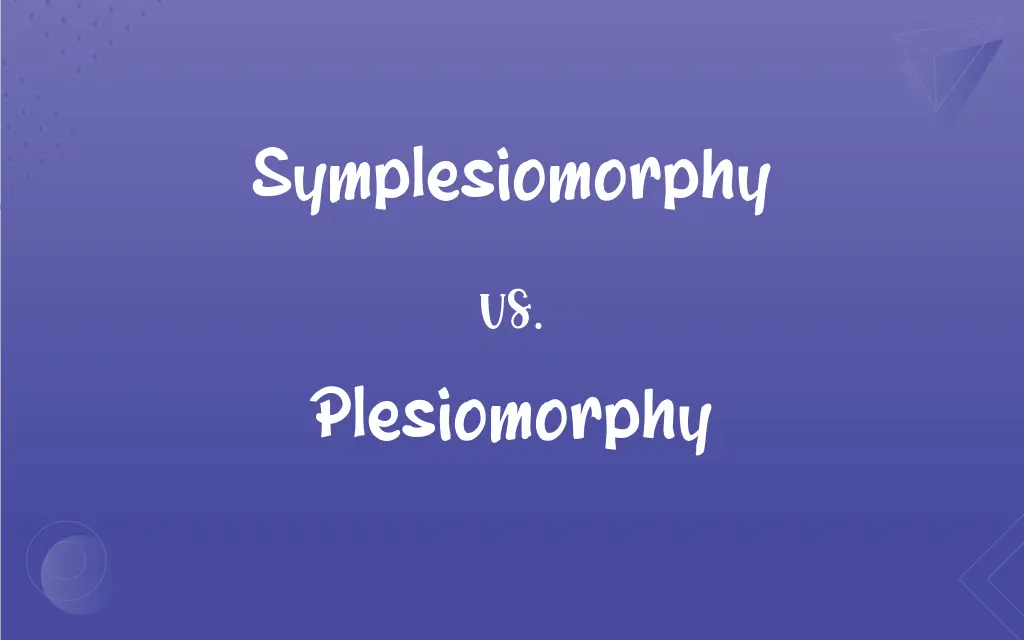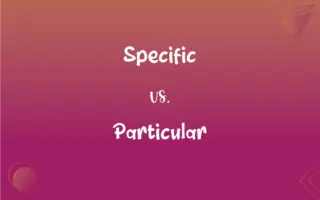Symplesiomorphy vs. Plesiomorphy: What's the Difference?
By Janet White & Harlon Moss || Updated on May 22, 2024
Symplesiomorphy refers to a shared ancestral trait found in multiple taxa, while plesiomorphy is an ancestral trait present in a single taxon or lineage.

Key Differences
Symplesiomorphy involves ancestral traits that are shared among several groups of organisms. These traits are inherited from a common ancestor and are retained across multiple descendant lineages. Plesiomorphy, on the other hand, refers to an ancestral trait found within a single taxon. It signifies a characteristic that existed in the common ancestor of a particular lineage and has been retained within that lineage over time.
Symplesiomorphies can complicate the construction of phylogenetic trees because they may suggest a closer relationship between groups that share the ancestral trait, even if those groups are not closely related. In contrast, identifying plesiomorphies helps in understanding the evolutionary history of a single lineage without necessarily comparing it to other groups.
The identification of symplesiomorphies is significant in differentiating between shared ancestral traits and derived traits, which are more useful in defining evolutionary relationships. Plesiomorphies, while informative about the history of a lineage, are less useful in distinguishing between different lineages because they do not indicate new evolutionary developments.
Comparison Chart
Definition
Shared ancestral trait among multiple taxa
Ancestral trait within a single taxon
Scope
Multiple descendant lineages
Single lineage or taxon
ADVERTISEMENT
Phylogenetic Use
Can mislead about close relationships
Highlights ancestral state in a lineage
Implication
Shared ancestry among multiple groups
Ancestral trait retention within a lineage
Example
Presence of a backbone in vertebrates
Presence of scales in reptiles
Symplesiomorphy and Plesiomorphy Definitions
Symplesiomorphy
An ancestral trait retained across different descendant lineages.
Symplesiomorphy can be observed in the limb structures of various terrestrial animals.
Plesiomorphy
Ancestral state retained without indicating close relationships with other groups.
The presence of teeth in early mammals is a plesiomorphy.
ADVERTISEMENT
Symplesiomorphy
A homologous trait present in a broad group of organisms.
The presence of jaws in fish and mammals is a symplesiomorphy from their common ancestor.
Plesiomorphy
A characteristic inherited from an ancestor specific to one lineage.
Plesiomorphy in reptiles includes the ancestral trait of laying eggs.
Symplesiomorphy
An ancestral trait not useful for defining specific evolutionary branches.
Symplesiomorphy does not help distinguish between closely related species.
Plesiomorphy
An ancestral trait found within a single taxon or lineage.
The presence of primitive feathers in certain dinosaurs is a plesiomorphy.
Symplesiomorphy
A trait shared by multiple taxa that originated from their common ancestor.
The presence of vertebrae is a symplesiomorphy among vertebrates.
Plesiomorphy
A primitive characteristic within a single evolutionary branch.
Plesiomorphy helps understand the evolutionary history of a taxon.
Symplesiomorphy
Shared primitive characteristics complicating phylogenetic analysis.
Identifying symplesiomorphy helps avoid misinterpreting evolutionary relationships.
Plesiomorphy
A trait that existed in the common ancestor of a particular lineage.
Scales in modern reptiles represent a plesiomorphy from their ancestors.
Symplesiomorphy
(cladistics) An ancestral trait shared by two or more taxa.
Plesiomorphy
An evolved character or trait that is shared by some or all members of a phylogenetic group and their common ancestor but is not unique to that group. A segmented spinal column is a plesiomorphy of mammals, being present as well in other groups such as fishes, reptiles, amphibians, and birds.
Plesiomorphy
(cladistics) A character state that is present in both outgroups and in the ancestors
FAQs
What is symplesiomorphy?
Symplesiomorphy is a shared ancestral trait found in multiple taxa.
Can a trait be both a plesiomorphy and a symplesiomorphy?
Yes, a trait can be a plesiomorphy within one lineage and a symplesiomorphy when shared by multiple taxa.
Why can symplesiomorphy be misleading in phylogenetic analysis?
It may suggest closer relationships among taxa that share ancestral traits even if they are not closely related.
What is the significance of plesiomorphy in evolutionary studies?
Plesiomorphy highlights the retention of ancestral traits within a single lineage, helping to understand its history.
How does symplesiomorphy differ from plesiomorphy?
Symplesiomorphy is shared among several groups, while plesiomorphy is an ancestral trait within a single taxon.
Can plesiomorphy indicate evolutionary stasis?
Yes, it can indicate that a lineage has retained ancestral traits without significant change.
How do symplesiomorphies affect the construction of phylogenetic trees?
They can complicate tree construction by implying close relationships where there are none.
Are symplesiomorphies used to define clades?
No, derived traits (synapomorphies) are more useful for defining clades.
What is an example of symplesiomorphy?
The presence of a backbone in vertebrates is an example of symplesiomorphy.
Why are plesiomorphies less useful in distinguishing between different lineages?
Plesiomorphies do not indicate new evolutionary developments and are less informative about divergence.
Do symplesiomorphies indicate recent common ancestry?
No, they indicate shared ancestry but not necessarily recent common ancestry.
What is a synapomorphy?
A synapomorphy is a shared derived trait that indicates common ancestry among a group of organisms.
Can a trait evolve from plesiomorphy to symplesiomorphy?
Yes, if a plesiomorphic trait becomes shared among multiple descendant lineages, it can be considered a symplesiomorphy.
How do ancestral traits influence modern taxonomy?
Understanding ancestral traits helps in reconstructing evolutionary relationships and histories.
What is an example of plesiomorphy?
The presence of scales in reptiles is an example of plesiomorphy.
What is an example of a misleading symplesiomorphy?
The presence of four limbs in amphibians, reptiles, birds, and mammals can be misleading without considering derived traits.
Why is it important to distinguish between ancestral and derived traits?
Distinguishing them helps accurately reconstruct evolutionary relationships and understand lineage divergence.
How do scientists differentiate between symplesiomorphy and synapomorphy?
Synapomorphies are shared derived traits, while symplesiomorphies are shared ancestral traits.
What role do symplesiomorphies play in taxonomy?
They help understand the broader evolutionary history but are less useful for fine taxonomic distinctions.
Why is identifying plesiomorphies important in paleontology?
It helps trace the evolutionary history and characteristics of ancient lineages.
About Author
Written by
Janet WhiteJanet White has been an esteemed writer and blogger for Difference Wiki. Holding a Master's degree in Science and Medical Journalism from the prestigious Boston University, she has consistently demonstrated her expertise and passion for her field. When she's not immersed in her work, Janet relishes her time exercising, delving into a good book, and cherishing moments with friends and family.
Co-written by
Harlon MossHarlon is a seasoned quality moderator and accomplished content writer for Difference Wiki. An alumnus of the prestigious University of California, he earned his degree in Computer Science. Leveraging his academic background, Harlon brings a meticulous and informed perspective to his work, ensuring content accuracy and excellence.































































